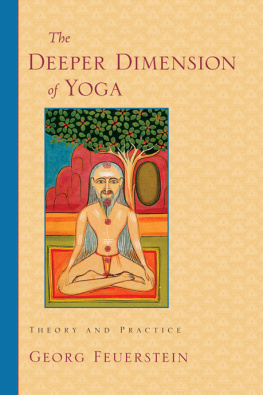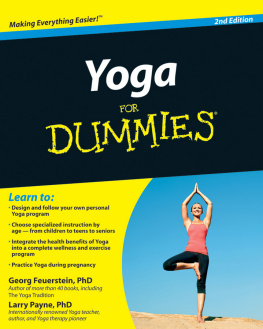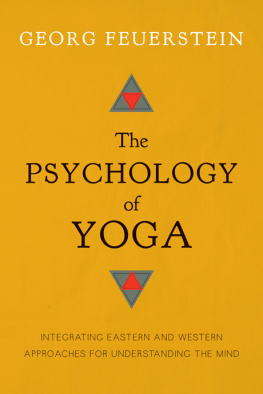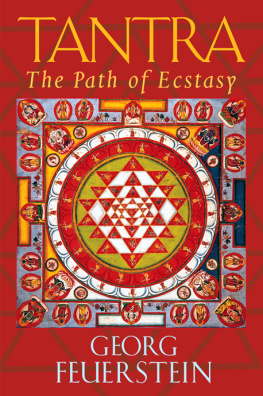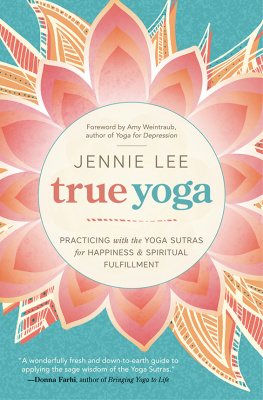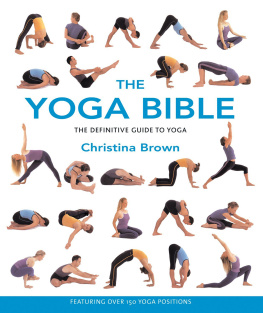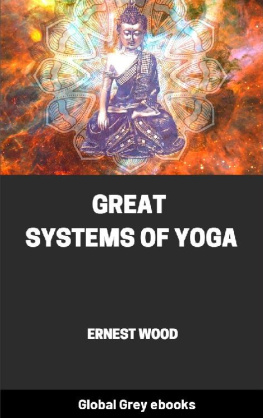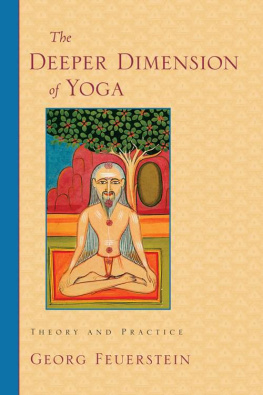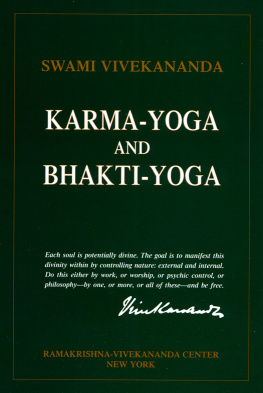George Feuerstein ably demonstrates the depth and profundity of Yoga as a spiritual discipline.
Spirituality & Health
His writing is lucid and accessible, without sacrificing any of the scholarly substance earned through three decades of intensive study, practice, research, and writing.
Yoga Journal
ABOUT THE BOOK
Here is a comprehensive survey of the full breadth and depth of the 5,000-year-old Yoga tradition, emphasizing its potent philosophy and spiritual vision. Georg Feuerstein demonstrates that Yoga is much more than a system of physical exercisesit is a profound path of self-transformation that encompasses a range of teachings, practices, and sacred texts that can help us cultivate wisdom, balance, and inner freedom, as well as physical health.
Feuerstein is one of the few Western scholar-teachers of Yoga whose writing and teaching penetrate the full richness and depth of this ancient tradition. Here he offers a collection of essays touching on all facets of the discipline.
Topics include:
- The different branches and styles of Yoga
- The ethical teachings of Yoga
- Yoga and vegetarianism
- Meditation and mantras
- Choosing a teacher
- Tantric Yoga
- The experience of ecstasy
GEORG FEUERSTEIN, Ph.D., is internationally respected for his work on Yoga and is the author of over fifty books. He has designed and taught several distance-learning courses on Yoga philosophy for Traditional Yoga Studies. For more information, go to www.traditionalyogastudies.com.
Sign up to learn more about our books and receive special offers from Shambhala Publications.

Or visit us online to sign up at shambhala.com/eshambhala.

THEORY AND PRACTICE
Georg Feuerstein
SHAMBHALA BOSTON & LONDON 2011 | 
|
Shambhala Publications, Inc.
Horticultural Hall
300 Massachusetts Avenue
Boston, Massachusetts 02115
www.shambhala.com
2003 by Georg Feuerstein
All rights reserved. No part of this book may be reproduced in any form or by any means, electronic or mechanical, including photocopying, recording, or by any information storage and retrieval system, without permission in writing from the publisher.
Library of Congress Catologing-in-Publication Data
Feuerstein, Georg.
The deeper dimension of Yoga: theory and practice / Georg Feuerstein.
p. cm
Includes bibliographical references and index.
eISBN 978-0-8348-2208-5
ISBN 1-57062-935-8
1. Yoga. I. Title.
B132.Y6 F48752003
181.45dc21
2002014201
Dedication
I dedicate this volume to everyone who, over the years, has contributed to my efforts in effecting a more profound public understanding of the traditional moorings of Yoga. May everyone be blessed with a joyous heart and peaceful mind!

I would like to wholeheartedly thank the many friends who directly or indirectly have contributed to the creation of this work. May all be blessed with peace and happiness!

P OSSIBLY 30 MILLION to 40 million people around the world practice Yoga today. By and large, they approach Yoga as physical fitness training. As one Yoga teacher observed: Yoga has been reduced to fitness, more specifically stretching, and yet more specifically stretching of the hamstrings. This comment would be funny if it were not sadly true. While any approach to Yoga practice is a potential gateway to the real thing, there is clearly a continued need to emphasize that Yoga is a spiritual tradition, which seeks to bestow happiness and inner freedom rather than merely physical fitness and health.
For the past thirty or more years, I have championed traditional Yoga. This book is yet another effort in the same direction. It consists of 78 essayslong and short27 of which stem from my long-out-of-print Sacred Paths, with the rest either taken from the website of the Yoga Research and Education Center (YREC) or newly written especially for this volume. All of them are concerned with various aspects of Yogas magnificent heritage extending over a span of 5,000 years. This translates into about 200 generations, as compared to the ten generations that make up the history of the United States. We can readily see how Yoga is a condensate of massive experience and knowledge. It is undoubtedly the greatest product of the genius of the Indic people, who have created the oldest continuous spiritually based civilization on Earth. Nowadays India is groaning under the growing burden of its 1 billion citizens and the onslaught of Western capitalism and consumerism, which clash with the Indic spiritual heritage. But there are still many noble individuals who, like the world-famous Mahatma Gandhi, look to the inherited ideals of wisdom for guidance and inspiration. They are never disappointed. For the ancient wisdom passed down from the Vedic seers and sages to modern seekers is as valid today as it was then.
Even today, despite widespread industrialization, India is still a land of religion and spirituality. It is rich in temples, shrines, saints, sages, yogins, and pious folk. The sacred festival of the kumbha-mel, celebrated in Allahabad in February 2001, attracted no fewer than 100 million. Skepticism and cynicism are rampant mostly in the sprawling urban environments. But increasingly those Indians who have received a Western-type education are ignorant and even dismissive of their spiritual heritage. Little is being done to preserve either the temples or the sacred literatures written in Sanskrit, Tamil, Marathi, and other Indic languages. Thus every year, many treasures are destroyed and lost forever. In 2000, in conjunction with Babajis Kriya Yoga Ashram in Montreal, YREC launched a project that will help preserve, edit, translate, and publish in book form as many Tamil Siddha Yoga manuscripts as can be found in South India. Swami Veda Bharati, the spiritual head of the Rama Ashrama in Rishikesh, is endeavoring to do the same relative to Sanskrit Yoga manuscripts. There are a sporadic few other efforts, but these all fall short of what ought to be done to preserve Indias spiritual heritage.
On the other hand, it is encouraging to see so many Westerners turning to Yoga and experiencing its benefits. Current estimates suggest that there are up to 20 million Yoga practitioners in the United States alone. In at least 99 percent of cases, their Yoga practice consists of doing Hatha-Yoga postures one or more times per week. Clearly, even this limited approach is producing some good results. According to a report by Intersurvey Inc. dated May 12, 2000, 9 percent of Americans (that is, some 25 million people) have tried Yoga, as opposed to 14 percent who have experimented with meditation of an unspecified nature and 3 percent who have tried Tai Chi. Yogas effectiveness has been rated 87 percent, as opposed to meditation, which came in at 85 percent, and Tai Chi at 73 percent, though it is not clear what criteria were used to determine this. Presumably Yoga stands here for the yogic postures (sana).
Yoga, of course, is so much more than postures, and its real power lies in the domain of mind training and self-transformation. It has been said that contemporary Yoga is highly reductionistic. This is true enough, yet I also see fitness Yoga as an opportunity for discovering Yogas deeper side. That deeper side is concerned with our spiritual destiny. The postures, if done correctly, will calm our nervous system and perhaps create sufficient space in our psyche to explore breath control. Then, when yogic breathing has put us in touch with the bodys life force (
Next page
